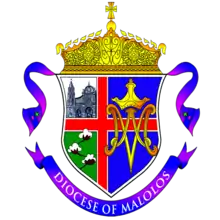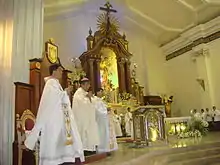Roman Catholic Diocese of Malolos
The Roman Catholic Diocese of Malolos (Latin: Dioecesis Malolosinae; Tagalog: Diyosesis ng Malolos; Spanish: Diócesis de Malolos) is a Roman Rite diocese of the Latin Church of the Catholic Church in the Philippines. The mother church of the Diocese is the Cathedral-Basilica of the Immaculate Conception located in Malolos City, Bulacan.[1]
Diocese of Malolos Dioecesis Malolosinae Diyosesis ng Malolos Diócesis de Malolos | |
|---|---|
 Coat of Arms | |
| Location | |
| Country | Philippines |
| Territory | |
| Ecclesiastical province | Manila |
| Statistics | |
| Area | 2,672 km2 (1,032 sq mi) |
| Population - Total - Catholics (including non-members) | (as of 2015) 3,841,210 3,303,441 (87.5%) |
| Parishes | 108 |
| Information | |
| Denomination | Roman Catholic |
| Sui iuris church | Latin Church |
| Rite | Roman Rite |
| Established | March 11, 1962 |
| Cathedral | Cathedral-Basilica of the Immaculate Conception |
| Patron saint | Our Lady of The Immaculate Conception |
| Current leadership | |
| Pope | Francis |
| Bishop | Dennis Cabanada Villarojo |
| Vicar General | Pablo S. Legaspi, Jr. |
| Website | |
| https://malolosdiocese.ph/ | |
The Diocese of Malolos, with jurisdiction over the Province of Bulacan and the City of Valenzuela in Metropolitan Manila and suffragan to the Archdiocese of Manila, was created on March 11, 1962 by Pope John XXIII. Manuel del Rosario was installed by Archbishop Salvatore Siino, the papal nuncio, as the first bishop of the Diocese. He was succeeded by Cirilo R. Almario in 1977 and died on October 14, 2016. While Rolando Tirona, who is now the Archbishop of Caceres, became the third bishop in 1996. Following the death of Jose Francisco Oliveros, the fourth bishop of Malolos, on May 11, 2018, Pope Francis appointed Honesto F. Ongtioco, Bishop of Cubao as the Apostolic Administrator of the Diocese on May 16, 2018. On May 14, 2019, Pope Francis appointed Dennis C. Villarojo, then Auxiliary Bishop of Cebu and Titular Bishop of Gisipa as the fifth Bishop Of the Diocese.
History
Bulacan was Christianized in the 1572 by the Augustinian Friars headed by Fray Diego de Herrera, Martin de Rada and Fray Diego Ordoñez de Vivar from Guadalajara Mexico the Western Bulacan became the centers of Augustinians Order in Towns of Calumpit with Hagonoy and Apalit, Bulakan with Bigaa and Caluya, Malolos with Quingua while on the Southern part comprising the Old Meycauayan was Christianized by Franciscans in 1578.
Bulacan Province which lies in the Central Plains of Luzon, or Region III. Bulacan is bounded by Nueva Ecija on the north, Aurora (Dingalan) on the northeast, Quezon (General Nakar) on the east, Rizal (Rodriguez) on the southeast, Metro Manila (Valenzuela City, Malabon City, Navotas City, Caloocan City and Quezon City) on the south, Manila Bay on the southwest, and Pampanga on the west. The province of Bulacan is rich in rice, in fruits and in poultry and fishpond production. Other products are sugar and corn.
Historically, Bulacan, together with other Central Luzon provinces, was among the first to take up arms against Spanish authorities. It played an important role in the Philippine Revolution of 1896. When the capital of the new Republic was moved from Bacoor in Cavite to Malolos in Bulacan, the First Revolutionary Congress met at the Barasoain Church, a landmark in Philippine history, to draft the first constitution of the First Philippine Republic. And on January 21, 1899 Emilio Aguinaldo, the first president of the First Philippine Republic, promulgated what is now known as the Malolos Constitution. It was the first important Filipino document to come out of people's representation.
Prior to the creation of the Diocese of Malolos, it is part of Archdiocese of Manila as Vicaria de La Inmaculada Concepcion or Vicaria dela Provincia de Bulacan with Malolos Church as the headquarters of Vicariate of Bulacan comprising the whole Province of Bulacan but later the province was divided into two vicariates, other one is for Franciscan riconandas of Meycauayan including Polo (now Valenzuela City)
The Diocese of Malolos was created upon the Papal Bull "Christi Fidelium" November 25, 1961 and it was officially opened on March 11, 1962, the Malolos Church became Cathedral and the site of the canonical installation of the first resident bishop of Malolos, Most Reverend Manuel del Rosario, D.D. For Malolos, it was a new chapter in its already fabled history. It was the late Pope John XXIII who created the Diocese of Malolos as a suffragan of the Archdiocese of Manila. In the celebration, Bishop del Rosario was installed by Archbishop Salvatore Siino, then papal nuncio to the Philippines.
In Guiguinto, Bulacan town, the Immaculate Conception Minor Seminary The seminary, considered the nucleus potential of the diocese, has become the alma mater of two hundred and fifty priests who have now assumed responsible positions in the diocese and its 100 plus parishes. The seminary has grown to include new buildings for a college seminary, a formation institute, and theology school.
A few years later two auxiliary bishops were assigned to Malolos: Most Reverend Leopoldo Arcaira who arrived in 1966, then Most Reverend Ricardo Vidal. When Monsignor Vidal was elevated to the position of archbishop and was assigned to Lipa, Pope Paul VI gave Malolos a young and energetic prelate, Most Reverend Cirilo R. Almario, Jr. He became the bishop of Malolos from December 15, 1977 up to January 20, 1996.
The third bishop is the former auxiliary bishop of Manila, Most Rev. Rolando Tria Tirona, OCD, a Carmelite Discalced. He started his episcopacy on the December, 1996. He was later transferred in June 2003 to the Prelature of Infanta to replace another Carmelite Discalced prelate, Bishop Julio Xavier Labayen, OCD. He is now the Archbishop of Nueva Caceres.
The fourth bishop is a priest from the Diocese of Gumaca in Quezon and formerly a Bishop of the Diocese of Boac, Marinduque, Most Rev. Jose Francisco Oliveros, DD. He took the office on May 14, 2004 and died on May 11, 2018.
The fifth bishop is a priest from the Archdiocese of Cebu in Cebu and formerly an Auxiliary Bishop of the Diocese of Cebu, Most Rev. Dennis C. Villarojo, DD. He took the office on May 14, 2019.
The Diocese of Malolos comprises the entire civil province of Bulacan and the city of Valenzuela in Metro Manila. Its titular patron is the Immaculate Conception whose solemnity is celebrated December 8. The population covered by the diocese is 1,650,000 of which 85 per cent are Catholics.
In June and July 1987, Bishop Cirilo Almario convened the First Diocesan Synod of Malolos. It had for its theme: "To Prepare for the Lord a Perfect People." Together with the priests and the Christian faithful of the province the Synod formulated its own vision-mission statement. To fulfill its mission, a restructuring of the diocesan organization was called for in line with the spirit of Vatican II.
The Second Synod of the Diocese was convened by Most Rev. Jose F. Oliveros, DD. It was held from April 8 to April 13, 2016. It had the theme "Contemplating the face of Christ and proclaiming God's transforming grace with unwavering faith towards the new evangelization in the Diocese of Malolos."


Bulacan: One of the bastion of early christian missions in Luzon 1572–1581
The present territory of the Diocese of Malolos historically traces to the early catholic missions as of 1572 of the Spanish Missionaries promulgated primarily by the Order of Saint Augustine (OSA) and secondarily in 1578 upon the arrival of the Order of Franciscan Minor (OFM) in the present day Province of Bulacan which was one of the earliest catholic missions in the Philippines 440 years ago.
CALUMPIT (1572) : Although it was established by Don Miguel de Legaspi and Martin de Goiti as Encomienda under Conquistador Sargento Mayor Juan Moron on November 14, 1571, it was christiniazed by Fray Diego Ordoñez de Vivar only in April 1572 where the Augustinians first arrived at Meyto and made it ministerios of Tondo but classified as semi-convent para cathequezar the east-west Pampanga and north-western Bulacan on May 3, 1572. They built a parish and convent under the patronage of San Nicolas de Tolentino with Fray Diego de Hererra as Prior but later replaced by Fray Martin de Rada, the prior provincial itself. The Church and Convent renamed San Juan Bautista in December 1576 and Our Lady of Presentation in Panducot as patroness. Former visitas of Calumpit are Macabebe, Candaba, Malolos, Hagonoy and Apalit, all separated as town later except Panducot, Meyto, Meysulao and Santa Lucia still a barrios of Calumpit.
BULAKAN (1578): It was established by the Augustinians under the direction of Tondo Curate, Fray Alonso Alvarado as one of the visitas of Tondo on April 30, 1575 and in August 1578 under the patronage of Our Lady of Assumption it became parish and convent having Fray Diego Vivar as its first minister. Bulakan was the former capital of the provincia de Bulacan and its former visitas are Guiguinto and Caluya (Balagtas) but the later where ceded to Malolos Convent in the 1600s.
MEYCAUAYAN (1578): Established thru the apostolic zeal of Fray Juan de Plasencia OFM and Diego Oropesa OFM who arrived in Lagolo in 1578, one of the first Franciscan missionaries in the Philippines and established the Catholic faith in old Meycauayan and its visitas such as Polo (Valenzuela), Obando (Catanghalan),San Jose del Monte, Santa Maria, Marilao and Bocaue.
MALOLOS (1580): Contemporary with Calumpit, it was primarily established secularly by Don Miguel Lopez de Legaspi and Martin de Goiti as Encomienda of Malolos under Don Marcos de Herrera on November 14, 1571, but before it was Christianized, on April 5, 1572 Legaspi merged the two encomiendas under the single name of Pueblo de Calumpit. Also on the same yeat Prior Provincial Martin de Rada acts as the prior of Calumpit when Fray Diego de Herrera dispatched to Spain, and it was made visita of Convent of Calumpit with Fray Diego Vivar as chaplain. The parochial beginnings was officially established June 11, 1580 under the patronage of Our Lady of Immaculate Conception with Fray Matheo de Mendoza as its first minister. Former visitas of Malolos are Quingua, Paombong and Bigaa.
HAGONOY (1581): Christianized by the friars from nearby Calumpit by Fray Diego Ordonez de Vivar. On December 28, 1578 Gov. Francisco Sande ordered the inclusion of Agonoy in the territory of Calumpit, thus it was also the same year when it was established as "ministerios" vis-a-vis, visita of the Calumpit Convent. In April 1581 it was separated as Parish and having Fray Diego Vivar as its first Prior but the Town is still under the Auspices and Justice from Calumpit until 1700s.
QUINGUA (1605): Quingua was originally one of the visitas of Malolos Convent and it was Christianized by Fray Matheo de Mendoza in 1581. When Fray Roque de Barrionuevo came he endorsed the creation of a quasi parish of Quingua in 1602, Fray Diego Pardo was installed as its first parochial minister in 1605. Former visitas of Quingua are Baliwag, Bustos and Angat.
Ordinaries
- Manuel P. del Rosario†: 11 Dec 1965 Appointed – 15 Dec 1977 Resigned, 23 March 2009 Died
- Cirilo R. Almario, Jr.†: 15 Dec 1977 Succeeded – 20 Jan 1996 Resigned, 14 October 2016 Died
- Rolando Octavus Joven Tria Tirona: 14 Dec 1996 Appointed – 28 Jun 2003 Appointed, Prelate of Infanta
- Jose Francisco Oliveros†: 14 May 2004 Appointed – 11 May 2018, Died
- Dennis Cabanada Villarojo: 14 May 2019, Appointed - 21 August 2019 - Installed by Luis Antonio Gokim Tagle
See also
References
| Wikimedia Commons has media related to Roman Catholic Diocese of Malolos. |